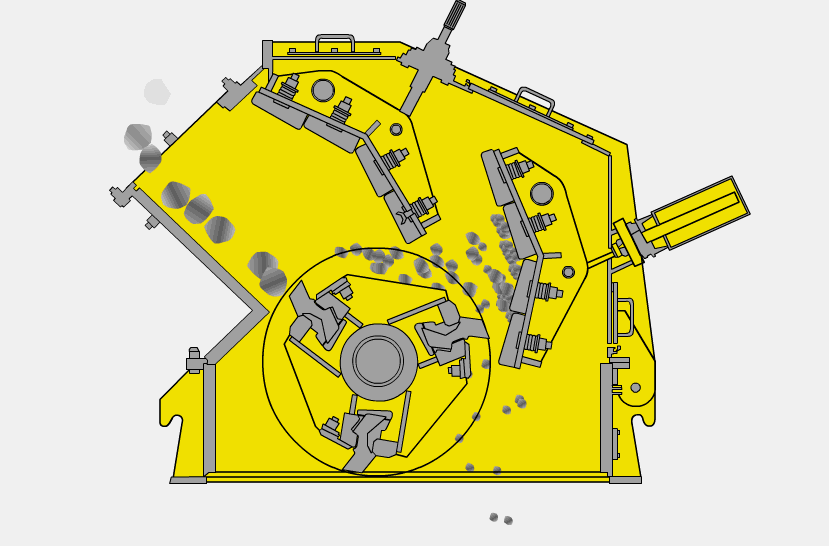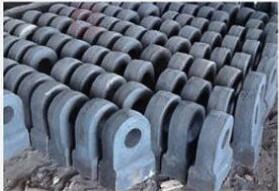Impact crusher and hammer crusher are both as a widely used crushing equipment, so they are often be compared and talked. The two are both with the advantages such as easy to operate and the price is favorable.
There are certain similarities from the crushing principle to the equipment structure, and they often serve as the secondary crusher in aggregate plant. But still, they also have certain differences in actual production, so let’s take a look at these two machines.
-
Structure and composition
The impact crusher is composed of a rotor, a blower, a percussion plate, a frame, a counterattack plate, and transmission components. The percussion plate is rigidly connected to the rotor.
The hammer is composed of rotor, hammer head, hammer frame, pin shaft, frame, crushing plate, screen plate, transmission parts, etc. The hammer head is hinged on the hammer frame.
-
Crushing cavity
The crushing cavity of the impact crusher is a bit more larger, so that the feeding material has a certain movement space and makes full use of the impact force.
In contrast, the crushing cavity of hammer crushing is small, the impact effect cannot be fully exerted, and the counter-attack crushing is a multi-cavity crushing structure, which is more fully crushed.
-
Crushing principle(Blow hammer and hammer head )
The hammer and the rotor are rigidly connected, and the inertia of the entire rotor is used to impact the material (free crushing, impact crushing, milling crushing), so that it not only crushes but also obtains greater speed and kinetic energy. The board hammer is to greet the input material from bottom to top for impact crushing, and throw it onto the upper counterattack board.

The hammer head of the hammer breaks the material by a single blow (free crushing, counter-attack crushing), and the speed and kinetic energy obtained by the material are limited. The hammer head strikes the material along the direction in which the material falls, with little crushing effect.
-
Wear resistance of vulnerable parts
The wear of the counter-breaking hammer often appears on the side facing the material, and its metal utilization rate can be as high as 45%-48%. When crushing limestone, the counterattack hammer is not worn seriously, but when crushing granite (high hardness, cone crusher), the hammer needs to be replaced constantly.

The broken hammer head is in a hanging state, and the wear occurs on the top, front, back and side. Compared with the blower, the hammer head wears more serious. The metal utilization rate of the hammer head is about 35%, and the rotor body itself may also be affected. Wear.
In addition, if the sieve plate at the bottom of the hammer is severely worn, the grille must be replaced, and the replacement of the sieve plate is also more complicated.
-
Discharge granularity adjustment device
The adjustment of the discharge particle size of the hammer crusher can only be achieved by replacing the bottom sieve plate.
The discharge particle size can be adjusted in many ways for counterattack, such as adjusting the rotor speed, adjusting the gap between the counterattack plate and the hammer (top bolt adjustment device), etc. The European version of counterattack can adjust the third by adding or reducing gaskets at the bottom. The distance between the impact board and the hammer.
Adjusting the gap between the impact frame and the rotor frame can achieve the purpose of changing the size and shape of the material discharged. The first and second counterattack plates pass through the top screw adjustment device. If there is a third counterattack plate (European counterattack breaker), it is adjusted by gaskets.
Take adjusting the distance as an example: first loosen the fixing screw of the adjustment shim, then the hydraulic cylinder moves to push the inner spring to make the distance between the impact plate and the rotor smaller, install the outer shim inside, and then loosen the hydraulic pressure Cylinder until the stop plate is stuck with the gasket inside.
-
Material moisture content requirements
The feed chute and the counterattack plate can be equipped with a heating device to prevent the sticking of materials, so materials with a large water content can be broken, and blockage is not easy to occur. For hammer breaking, heating cannot be used to prevent material from sticking, and it cannot meet the crushing work of materials with high water content.
-
Material blocking phenomenon
Relatively speaking, the impact cracking is not easy to cause blockage. One is that it can be equipped with a heating device to prevent the material from clogging due to stickiness. The other is that there is no grate at the bottom of the impact. The product size is determined by the gap between the impact plate and the hammer. Therefore, when dealing with materials with excessive water content, it can avoid the phenomenon of blocking the grate when crushing wet materials.
The hammer crusher is equipped with a bottom screen, which increases the possibility of clogging.
-
Crushing ratio and finished product shape
The crushing ratio of counterattack can reach more than 50, and the particle shape of the finished material is good. Under the action of impact, the material to be crushed is often broken along its fragile layer. This selective crushing method has uniform discharge particle size, the discharge is cubic, and the content of fine powder and dust is low. Therefore, where cubic particles are required, such as the non-slip pavement of high-grade highways, counter-attack breaking can be used as the final breaking equipment to produce concrete aggregates.
The crushing ratio of the hammer crusher is generally 10-25, and the higher one can reach 50. The product has more granular needles and flakes and higher powder content.
-
Scope of application
Both are suitable for crushing medium-hard materials, but impact crushers are mostly used as secondary crushing equipment, while hammer crushers are mostly used in cement production lines. They can be used as limestone raw material crushing equipment, and can also be used as primary crushing in sand and gravel co-production projects. equipment.
-
Use and maintenance
In the market, the advanced counterattack crushing frame part is a three-part structure, only need to open the rear casing of the crusher, you can replace the hammer, counterattack board, liner and other maintenance operations, and the parts are interchangeable Strong, with few varieties of wearing parts, which facilitates the procurement and management of spare parts.
The hammer crusher has many hammer heads, it takes a lot of time and manpower to replace a set of hammer heads, and the maintenance and maintenance costs are high. The replacement of the bottom screen is also troublesome.